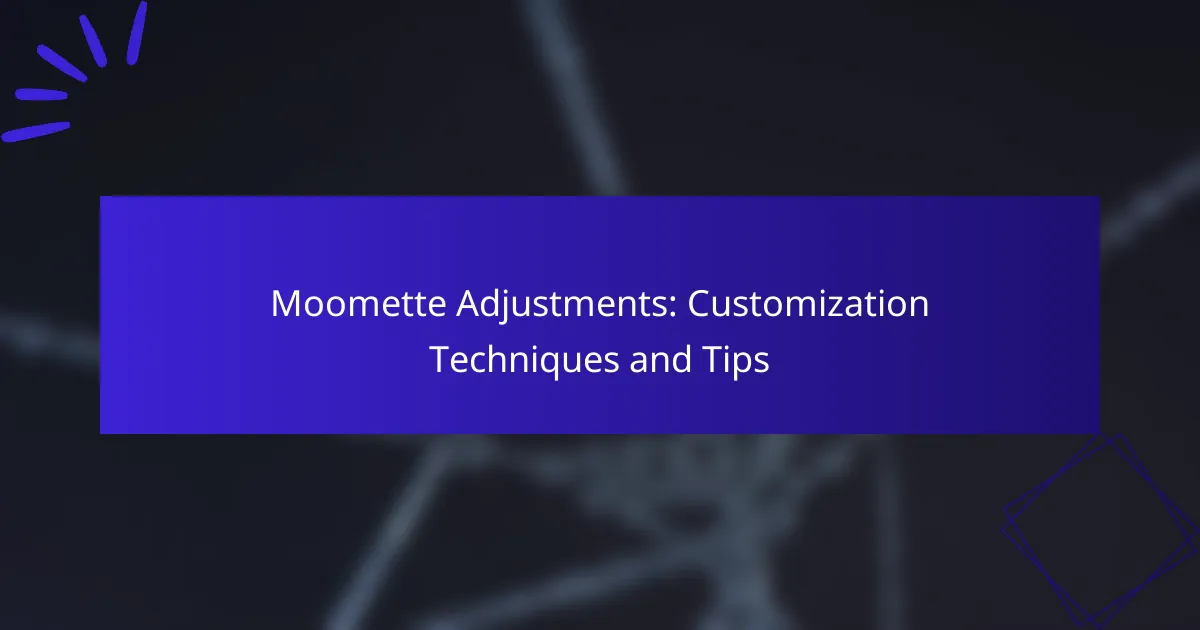Moomette adjustments offer users the opportunity to enhance their experience through personalized customization techniques. By focusing on key areas such as color settings, layout options, and content features, users can create an interface that aligns with their individual preferences and needs. Utilizing built-in tools and third-party plugins further empowers users to tailor their Moomette experience for improved interaction and enjoyment.
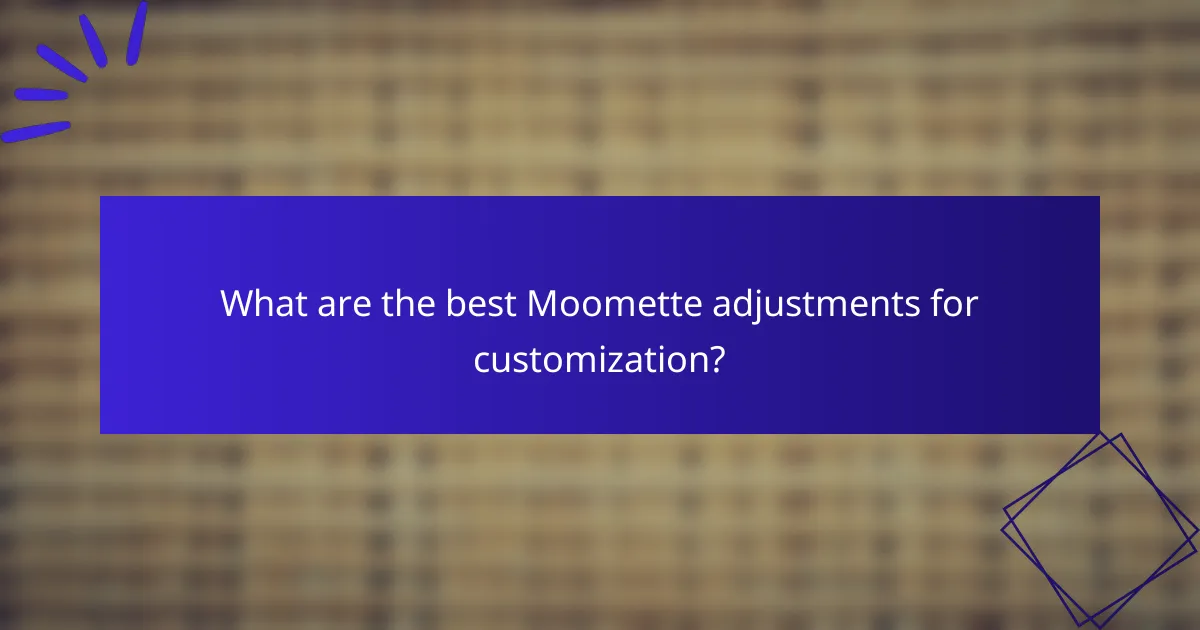
What are the best Moomette adjustments for customization?
The best Moomette adjustments for customization focus on enhancing user experience through tailored settings. Key areas include color settings, layout options, and content features, allowing users to create a personalized interface that meets their needs.
Adjusting color settings
Adjusting color settings in Moomette can significantly impact the visual appeal and usability of the interface. Users can select from a palette of colors to customize backgrounds, text, and highlights, ensuring readability and aesthetic preference.
Consider using contrasting colors to improve visibility, especially for text against backgrounds. For example, dark text on a light background is often easier to read. Aim for color combinations that are not only visually pleasing but also accessible to those with color blindness.
Modifying layout options
Modifying layout options allows users to arrange elements on the screen according to their workflow preferences. Moomette offers various templates and grid configurations that can be adjusted to prioritize frequently used features or tools.
When selecting a layout, think about the tasks you perform most often. For instance, if you frequently access certain tools, position them prominently. Avoid cluttering the interface; a clean layout enhances focus and efficiency.
Personalizing content features
Personalizing content features enables users to tailor the information displayed to their specific interests or needs. Moomette allows for the addition or removal of widgets, feeds, and notifications based on user preferences.
To optimize your experience, regularly review which features are most beneficial. For example, if a particular news feed is not relevant, consider removing it to streamline your interface. Keep in mind that personalization should enhance usability without overwhelming the user with too many options.

How can Moomette adjustments improve user experience?
Moomette adjustments enhance user experience by tailoring interface elements to better meet individual preferences and needs. These customizations can lead to more intuitive interactions, ultimately making the platform more enjoyable and efficient for users.
Enhanced navigation
Improving navigation through Moomette adjustments allows users to find information quickly and easily. Customizable menus, shortcuts, and layout options can streamline the user journey, reducing frustration and increasing satisfaction.
Consider implementing features like collapsible menus or customizable toolbars that let users prioritize their most-used functions. This can significantly decrease the time spent searching for tools or information, leading to a more fluid experience.
Increased engagement
Moomette adjustments can boost user engagement by creating a more personalized environment. When users can modify settings such as themes, notifications, or content preferences, they are more likely to interact with the platform regularly.
For instance, allowing users to select their preferred content types or adjust notification settings can lead to higher participation rates. Regularly soliciting user feedback on these adjustments can help refine features and maintain engagement over time.
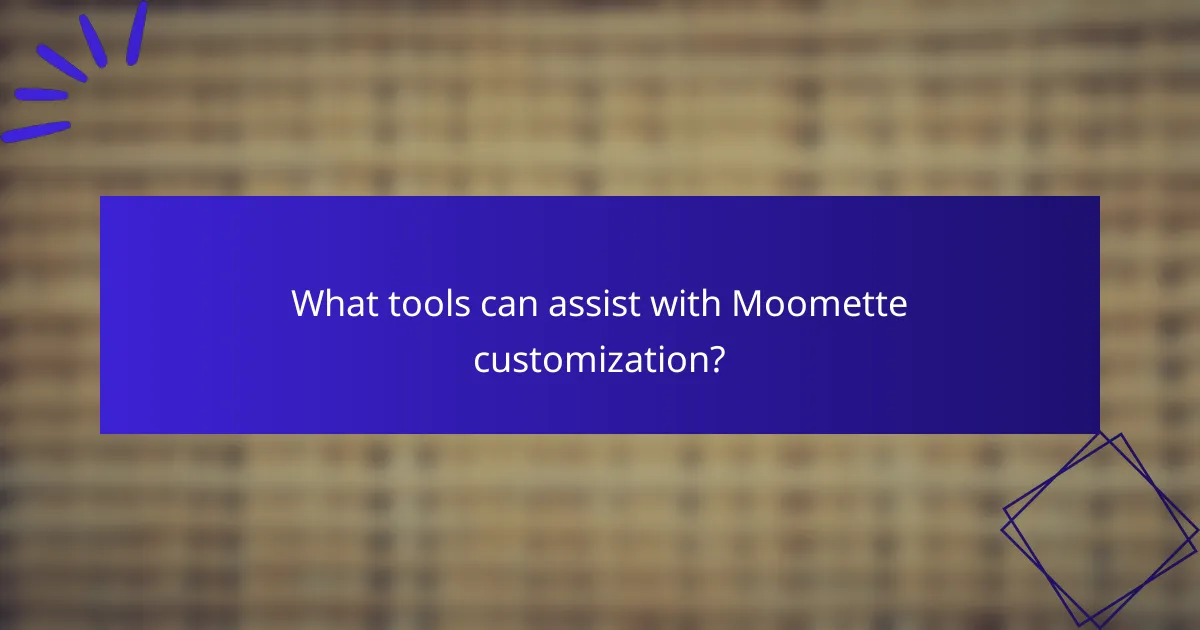
What tools can assist with Moomette customization?
Several tools can enhance Moomette customization, including built-in dashboards and third-party plugins. These resources allow users to tailor their Moomette experience to better meet their specific needs and preferences.
Moomette customization dashboard
The Moomette customization dashboard is a user-friendly interface that allows users to modify various aspects of their Moomette setup. This tool typically includes options for adjusting themes, layouts, and content settings, making it easy to create a personalized experience.
To effectively use the dashboard, familiarize yourself with its features. Look for sections dedicated to design, functionality, and user engagement. Prioritize changes that align with your goals, whether it’s enhancing aesthetics or improving user navigation.
Third-party plugins
Third-party plugins can significantly extend the functionality of Moomette, offering additional features that may not be available in the default setup. These plugins can range from SEO tools to social media integration, allowing for a more comprehensive customization experience.
When selecting plugins, consider compatibility with your current Moomette version and the specific needs of your project. Always check user reviews and support options to avoid common pitfalls, such as performance issues or security vulnerabilities. Aim for plugins that are regularly updated and well-supported to ensure long-term reliability.
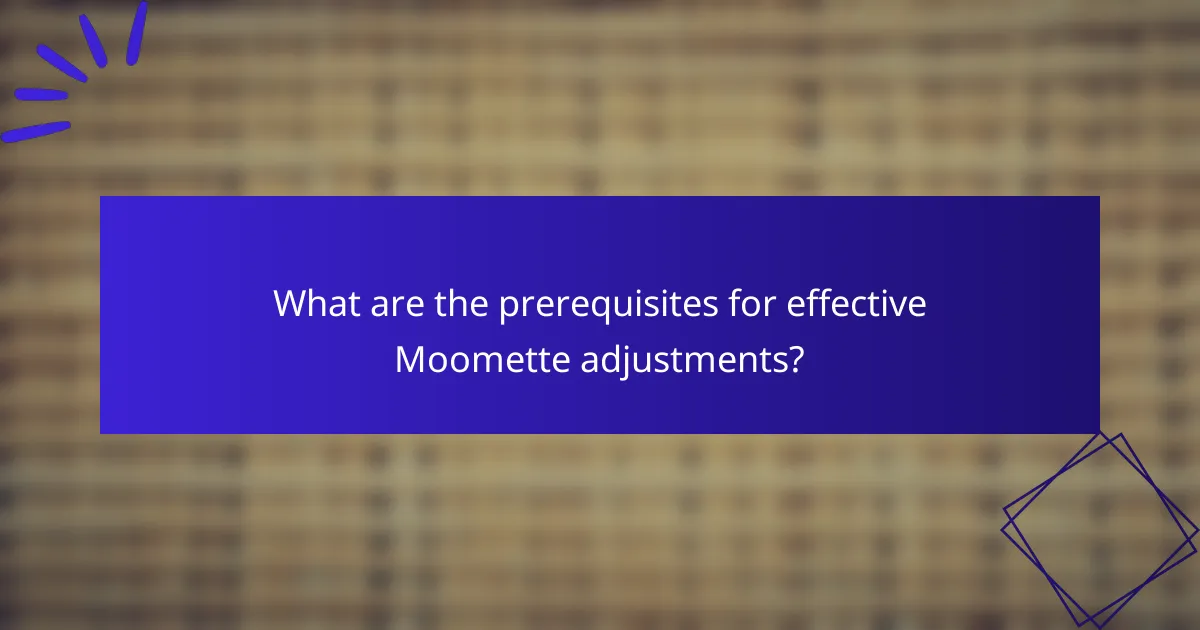
What are the prerequisites for effective Moomette adjustments?
Effective Moomette adjustments require a clear understanding of user preferences and familiarity with Moomette’s features. These prerequisites ensure that customizations align with user needs and maximize the platform’s capabilities.
Understanding user preferences
To tailor Moomette effectively, start by gathering insights into user preferences. Conduct surveys or interviews to identify what features users value most, such as interface layout, color schemes, or functionality. This information helps prioritize adjustments that enhance user satisfaction.
Consider creating user personas to represent different segments of your audience. This approach allows you to visualize how various users might interact with Moomette, guiding your customization efforts to better meet their specific needs.
Familiarity with Moomette features
Being well-versed in Moomette’s features is crucial for making effective adjustments. Familiarize yourself with the platform’s customization options, including settings for layout, themes, and functionality. Understanding these features enables you to leverage them effectively to create a more personalized user experience.
Regularly review Moomette’s updates and documentation to stay informed about new features and enhancements. This knowledge will help you adapt your adjustments as the platform evolves, ensuring that your customizations remain relevant and effective over time.
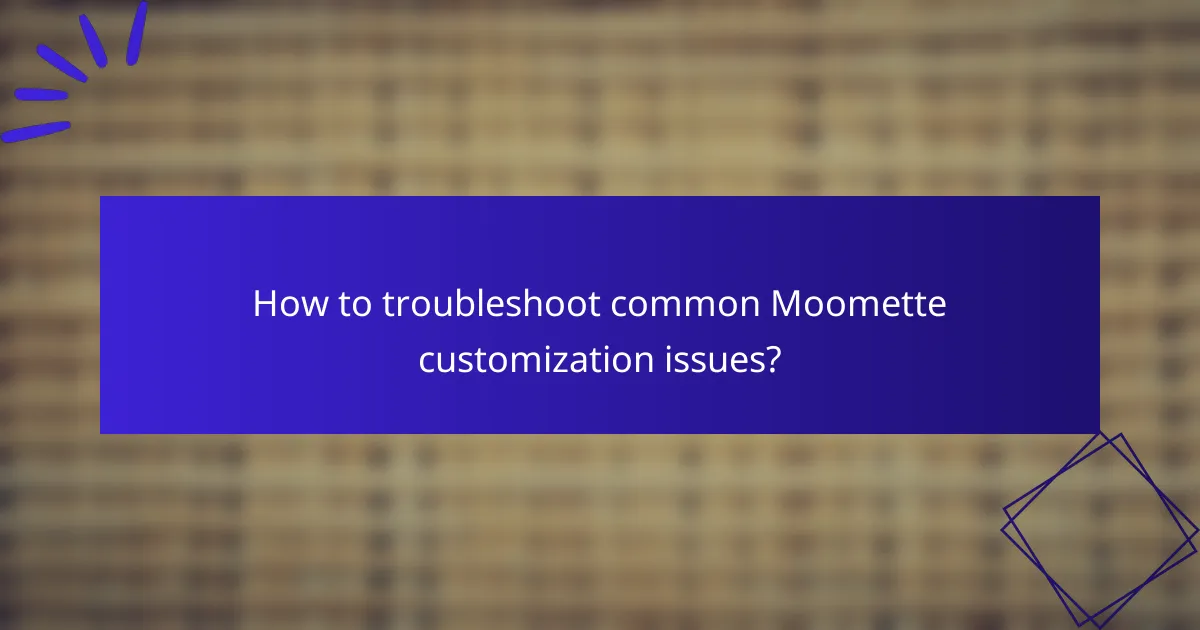
How to troubleshoot common Moomette customization issues?
To troubleshoot common Moomette customization issues, start by identifying the specific problem, whether it’s layout conflicts or plugin compatibility. Understanding these areas will help you apply effective solutions and enhance your customization experience.
Identifying layout conflicts
Layout conflicts often arise from overlapping CSS styles or incompatible themes. Begin by inspecting your website using browser developer tools to pinpoint which elements are causing the issue. Look for discrepancies in padding, margins, or positioning that may lead to visual misalignment.
To resolve layout conflicts, consider using a child theme to make adjustments without affecting the main theme. This allows you to test changes safely. Additionally, ensure that your custom CSS is loaded after the theme’s CSS to override any conflicting styles effectively.
Resolving plugin compatibility
Plugin compatibility issues can disrupt Moomette’s functionality, often resulting from outdated plugins or conflicting scripts. Check for plugin updates regularly and disable any recently added plugins to identify the source of the problem. This process helps isolate which plugin is causing the conflict.
If you find a conflicting plugin, look for alternatives that offer similar features without compatibility issues. Additionally, consult the plugin documentation or support forums for known conflicts and recommended solutions. Keeping your plugins updated and compatible with your Moomette version is crucial for smooth operation.
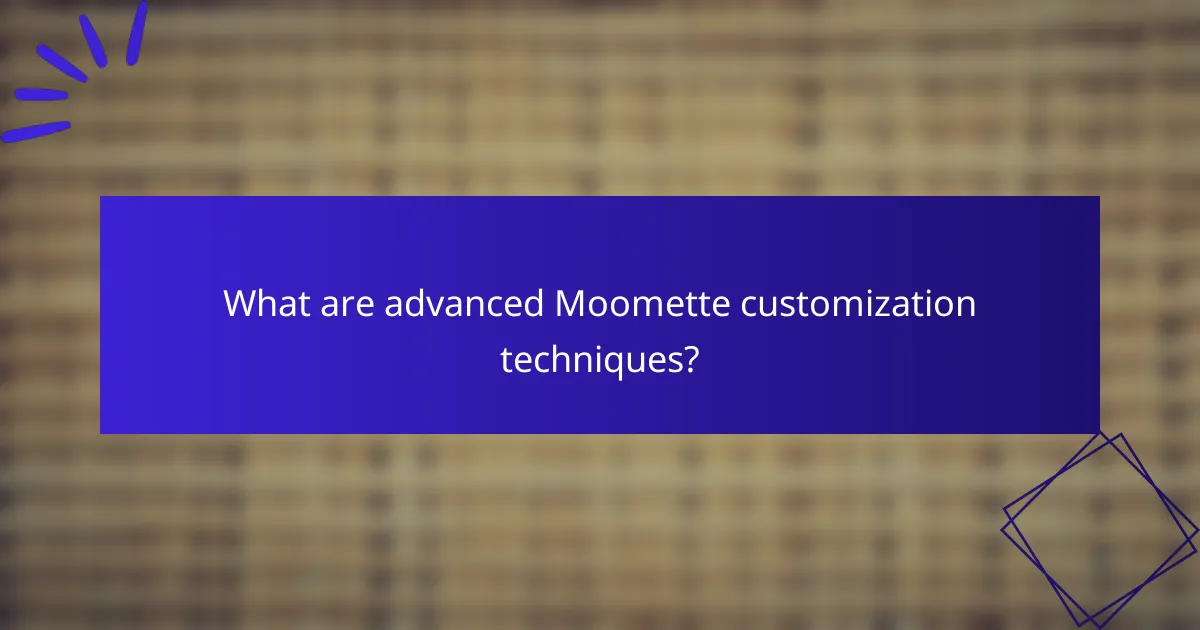
What are advanced Moomette customization techniques?
Advanced Moomette customization techniques involve using CSS and JavaScript to enhance the functionality and appearance of your Moomette site. These methods allow for tailored user experiences, improved aesthetics, and additional features that standard settings may not provide.
Utilizing CSS for deeper customization
CSS (Cascading Style Sheets) enables you to modify the visual aspects of your Moomette site extensively. You can change colors, fonts, layouts, and other design elements to match your brand identity. For instance, using specific CSS selectors, you can target elements like headers or buttons to create a unique look.
When customizing with CSS, consider using a responsive design approach to ensure your site looks good on various devices. Tools like media queries can help adjust styles based on screen size. Avoid overusing complex styles, as they can slow down loading times and affect user experience.
Implementing JavaScript enhancements
JavaScript allows for dynamic interactions on your Moomette site, such as animations, form validations, and interactive elements. By adding JavaScript, you can enhance user engagement and streamline navigation. For example, you might implement a dropdown menu that appears on hover, improving accessibility to various sections of your site.
When using JavaScript, keep performance in mind. Aim for low-impact scripts that do not hinder loading times. Utilize libraries like jQuery for simplified coding, but ensure you do not overload your site with unnecessary scripts, as this can lead to slower performance and a poor user experience.
